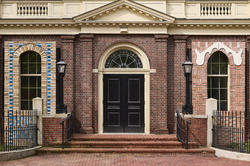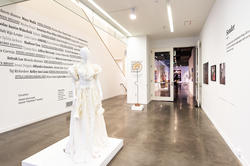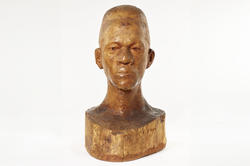RISD students create two site-specific interventions that aim to make the museum and its holdings more accessible to diverse visitors.
RISD Museum Presents Extraordinary Collection of Historical French Wallpaper

A new exhibition at the RISD Museum features historical French wallpaper acquired in 1934 by then RISD President Helen Metcalf Danforth. Purchased from late collectors Charles and Frances Wilson Huard in part to keep them safe as the winds of World War 2 began to blow, the rare samples of preserved wallpapers, borders, fragments and preparatory design drawings are on view through May 2025 in the very same space where a smaller selection was exhibited in 1935.
“Today, our focus is on technique, materiality and process, which is what makes us unique among art museums,” says RISD Museum Director Tsugumi Maki. Organized by Associate Curator of Decorative Arts and Design Emily Banas, The Art of French Wallpaper Design is accompanied by an interactive digital catalogue with essays exploring the history of the collection, wallpaper’s relationship to print history and the role of conservation in caring for works on paper.
“My goal in curating the show was to highlight stories of design, production and use,” Banas says, “and to make clear the deep connections between printmaking and historical techniques for creating wallpaper.”


The samples on view were made in France between 1770 and 1840 using the process of woodblock printing. Each example reflects hundreds of hours of collaborative effort by designers, woodblock carvers and printers, who used multiple blocks—sometimes more than 100 for one design—to produce a wide range of colors and repeating patterns, from florals to abstracts to mythological scenes.
The museum partnered with Adelphi Paper Hangings in Sharon Springs, NY to re-create a 1799 design by Paris-based manufacturer Bon. Museum visitors are welcomed into the gallery with a fascinating video detailing the process used to create the reproduction and may be surprised by the print’s contemporary vibe.
“Many of these designs look modern because of their geometric forms and bright colors,” Banas notes. “We also have four original woodblocks on display, artifacts that give viewers a sense of how artists were able to create this incredible level of detail, shading and dimensionality hundreds of years ago.”


At the time, wallpaper was a less expensive alternative to plasterwork, gilding and textile wall coverings embraced by Europe’s burgeoning middle class. People were able to create custom assemblages using panels purchased from the manufacturers, which also provided extra paper in case buyers needed to make repairs over time. Everything was hand-printed before the 1850s, when roller printing was introduced.
Manufacturers such as Zuber, Joseph Dufour and Jean-Baptiste Réveillon as well as lesser-known artisans created increasingly complex compositions featuring vibrant colors and textures. They used techniques like flocking, in which they glued chopped wool fibers to the paper to create surface texture; irisé, brushing on multiple paint colors at once to create an iridescent rainbow effect; and satination, working with a specific kind of paint that could be hand-polished to a high sheen.
“I am thrilled to re-introduce this extraordinary collection,” says Banas, “and I’m certain the material will challenge contemporary notions of what ‘historic design’ looks like.”
Simone Solondz / images courtesy RISD Museum
November 27, 2024


